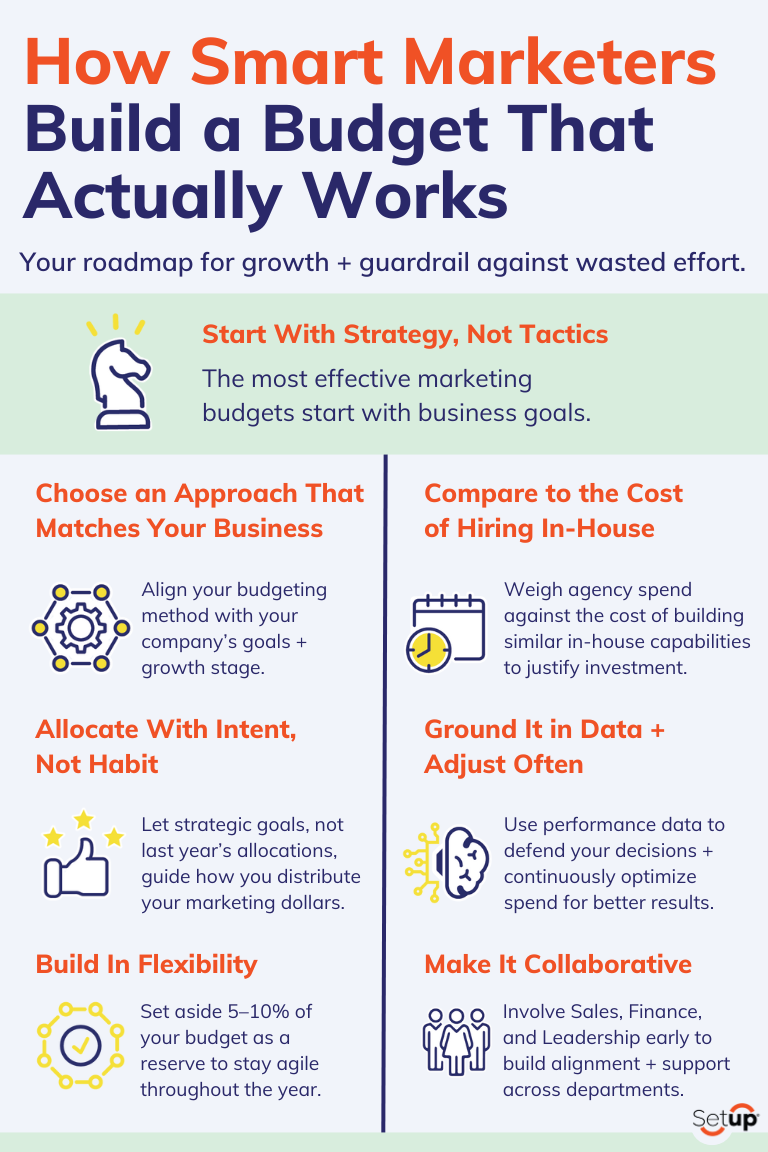How Smart Marketers Build a Budget That Actually Works
Creating a marketing budget isn’t just a financial exercise; it’s a strategic act. It’s your roadmap for growth, your guardrail against wasted effort, and, when done well, your strongest case for internal alignment and external results.
But while most marketers know how much they wish they could spend, far fewer know how much they should. So, where do you begin?
Start With Strategy, Not Tactics
The most effective marketing budgets don’t start with a list of channels or campaigns; they start with business goals. Whether you're entering a new market, launching a product, growing revenue in a key segment, or strengthening retention, your marketing investments should directly support these outcomes.
Think of the budget as a tool to fund the initiatives that will have the greatest impact. It’s less about “how much should we spend on email?” and more about “what do we need to achieve, and what combination of efforts will get us there?”
Read More: The Marketing Budget - Where Marketers Go Wrong + How to Get it Right
Choose a Budgeting Approach That Matches Your Business
There are several ways to structure a budget, and the right one often depends on your company’s stage, industry, and priorities.
Some marketers use a percentage-of-revenue model—allocating 5 to 10 percent of projected gross revenue to marketing. That works well as a general rule of thumb, especially in early conversations with Finance. Others build their budgets using an objective-based model, starting with a desired outcome (such as a specific number of qualified leads or a certain amount of pipeline) and working backward to define the spend required to achieve those goals.
More established companies may default to incremental budgeting, using last year’s plan as a baseline and making modest adjustments. And some look to competitive benchmarks to ensure they’re not falling behind category norms.
Each method has its pros and cons. What matters most is aligning your approach with the results you’re expected to deliver, and being ready to explain why your proposed spend makes sense.
Read More: 6 Tips to Maximize Your Marketing Budget
Compare to the Cost of Hiring In-House
One often overlooked but powerful technique for shaping your marketing budget is to consider what it would cost to bring the required work in-house.
For example, imagine you’re exploring agency support for media strategy, creative production, analytics, and campaign execution. To build that same capability internally, you might need a marketing strategist, digital campaign manager, designer, content producer, and analyst. Depending on your market, those salaries (plus benefits and overhead) can easily add up to $400,000 or more annually.
By contrast, a $15,000 per month agency retainer (approximately $180,000 per year) might provide you with access to a cross-functional team with broader experience, strategic oversight, and executional expertise. While not a perfect one-to-one comparison, thinking in terms of full-time employee (FTE) equivalents helps you quantify the value of external support and create a more persuasive business case.
This framing is particularly effective when discussing marketing headcount limitations or attempting to secure budget approval from finance leaders who tend to think in terms of salaries and operating expenses.
Allocate With Intent, Not Habit
Once you’ve determined your overall budget, the next step is allocating it in ways that reflect both your goals and your growth stage.
For a brand looking to scale fast, paid media and lead generation might take the lion’s share. If you’re in a repositioning phase, you may prioritize content, brand storytelling, and PR. And if you're setting the stage for long-term brand equity, investments in creative, website infrastructure, and strategic advisory work will matter more.
Whatever the mix, be mindful of falling into autopilot. Just because a channel or partner received 20% of the budget last year doesn’t mean it deserves the same now. Let your goals, not habits, drive distribution.
Build In Flexibility
The most sophisticated budgets allow for change. Even the best-laid plans can shift when a new opportunity arises, a campaign underperforms, or business priorities evolve.
That’s why it's wise to keep a portion of your budget unallocated at the start, typically 5–10 percent, to respond to what you learn throughout the year. This “strategic reserve” allows you to experiment, move quickly, or double down on what’s working.
Read More: Overcoming the Fear of Planning a Marketing Budget
Make It Collaborative
Your budget may live in the marketing department, but it doesn’t exist in a vacuum. Involve Sales early to ensure pipeline targets align. Engage Finance to confirm assumptions and timelines. And loop in Leadership to tie marketing investment to business health.
When stakeholders understand the “why” behind your budget and see how it connects to the outcomes they care about, they’re more likely to support your plan and advocate for your team.
Ground It in Data + Adjust Often
Perhaps the most important thing to remember is that a marketing budget is not a fixed contract; it is a flexible allocation of resources. It’s a dynamic roadmap that should evolve with performance. Review your numbers regularly, assess impact, and reallocate when needed.
Use your existing data to defend your decisions. Point to metrics like customer acquisition cost (CAC), return on ad spend (ROAS), cost per lead, and marketing-sourced revenue to show how your investments translate into real business value.
A well-constructed marketing budget isn’t just about how much you spend—it’s about how smartly you spend it. Start with strategy. Choose a model that fits. Compare against what it would cost to hire. Allocate with purpose. And stay agile.
When you approach budgeting with this kind of clarity and intention, you’re not just funding activity—you’re fueling results.
Need help aligning your marketing investment with the right agency partners?
Setup helps marketing leaders quickly connect with our network of vetted agencies tailored precisely to your needs, budget, and goals, at no cost to you.
Not sure where to start?
Download our free Marketing Budget Template to build, manage, and optimize your marketing spend confidently. This practical tool will help you structure your investments, ensure alignment with strategic goals, and clarify your agency requirements.
Then, when you're ready to find the right agency partners, we're here to guide you every step of the way. Let’s talk.
































Over the past year, we’ve watched the following patterns emerge across seemingly unrelated sectors: rising consumer expectations, demand for authenticity, growing complexity, and the tension between automation and human connection.
We interviewed multiple marketers from an array of industries in our blogs below, and we discovered consistent trends across the board. Check out all of our industry blogs throughout 2025 from leaders at Blackbaud, Hiscox USA, Mimedx, MONPURE, Kimberly-Clark Professional, and more.